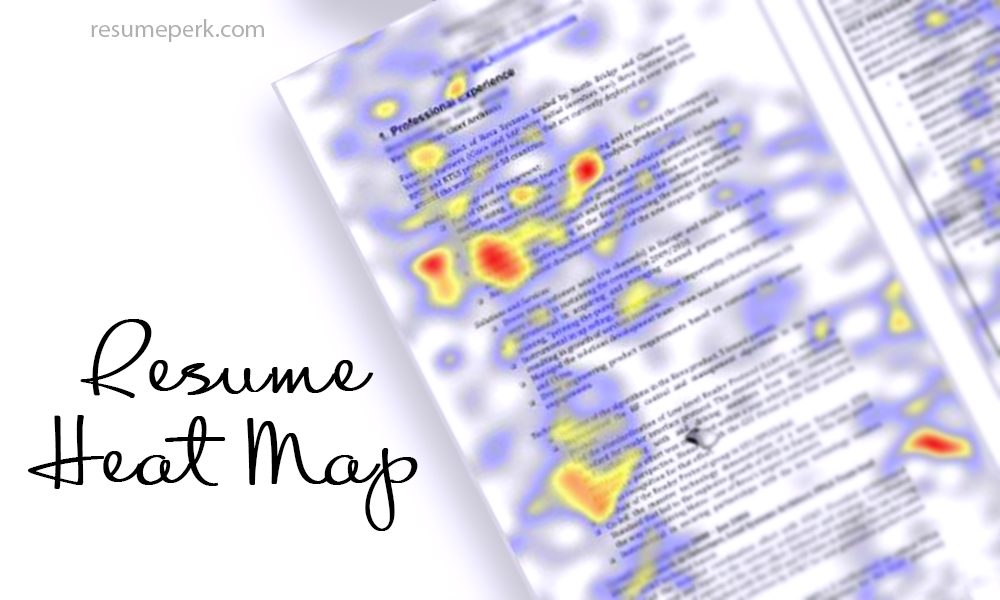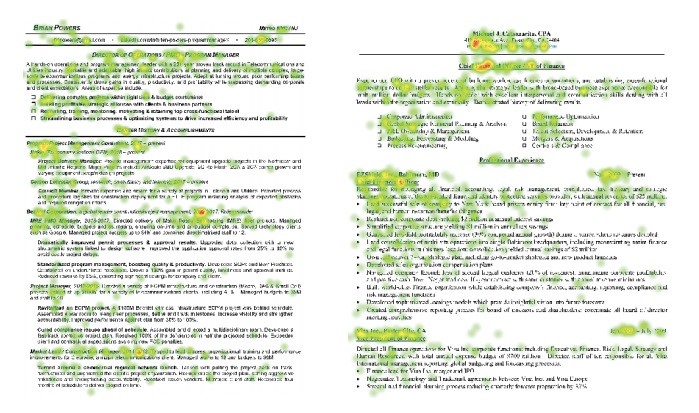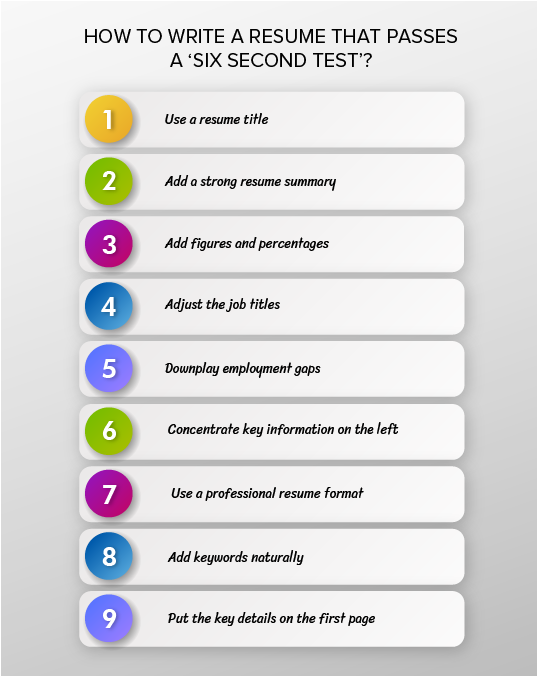Resume Heat Map: How Employers See Your Resume in 2019
 So, you’ve sent a resume to the company. Have you ever been curious about what happens next? The recruiter quickly scans each incoming resume to determine whether they are a fit for the organization. To increase your chances of getting noticed, you have to be familiar with how exactly the recruiters read resumes.
So, you’ve sent a resume to the company. Have you ever been curious about what happens next? The recruiter quickly scans each incoming resume to determine whether they are a fit for the organization. To increase your chances of getting noticed, you have to be familiar with how exactly the recruiters read resumes.
Theladders.com has thrown light on this matter. They have conducted an eye-tracking study which reveals what recruiters pay attention to when scanning resumes with "resume maps". Today, a writer of our professional resume help company will explain you the key insights of this study and help your resume get noticed. And, if you struggle getting interviews, you can always get a resume done by our pro resume writer. We will showcase your biggest professional strengths just in the right place to help you get noticed.
How much time recruiter spends on each resume in 2019?
You’ve probably heard of the famous ‘six-second rule’ assuming that a recruiter only spends 6 seconds reviewing your resume. Well, this isn’t the case anymore. A 2018 study exposed that the time spent on each resume is now 7.4 seconds. (Still not much, huh?)
The study tracked eye movements of recruiters reading resumes. Darker spots mean more time spent reviewing each particular section.

In these 7.4 seconds, the recruiter will look at your name, current job title and company, start-end dates, earlier job titles and education. The summary will get a bit of attention as well. To find out how to present your key information within this short time frame, read below.
What the recruiters look at when reading your resume?
- Name and contact details
This section is typically looked through, with one exception. If you are located not in the same area as your employer, and they don’t offer compensation for relocation, your resume might be rejected. So, if you are willing to relocate for the job at your own expense, use a local address in the resume. - Career summary
At this point, your career summary is quickly skimmed through. The recruiter takes a glance at your summary of qualifications to determine whether your qualifications are sufficient for the position. - Job titles and company names
Recruiters look for relevant job titles and famous company names. Big brands such as Google, Amazon or JetBlue Airways immensely add value to you as a candidate. Employment dates matter as well. Ideally, you should be currently employed with no career gaps. - Education
Most jobs have educational requirements. An advanced degree and a prestigious school can help you get shortlisted, too. - Recruiters use the F-pattern
As a rule, recruiters read the first few lines of your resume and then go down scanning the first word in each line. This is called the F-pattern.
How to pass the 7.4-second test?

You have little time to make a great first impression. So, your resume has to instantly communicate that you are a fit for the position. To create a good resume which will definitely pass the quick scanning, follow these steps:
- Use a resume title
Right after your name and contact info, put a resume title that matches the title of the job you’re aiming for. Firstly, it eases the recruiters’ job as there might be multiple job openings in the company. And secondly, it sets the tone for the rest of your resume content since you position yourself as a qualified professional. - Write a strong summary statement
A quality written summary is what differentiates the top-performing resumes from the mediocre ones. Moreover, the summary is most likely the only section that the recruiters will read during the initial screening. So, put enough effort to write a summary which positions you well, with all core strengths and major accomplishments highlighted. If you need more advice on crafting an effective summary, read here: https://resumeperk.com/blog/how-to-write-a-resume-summary-statement-10-examples. - Make use of figures
Figures and percentages in the text make the reader stop for a second and take notice. Moreover, figures add credibility to your resume and serve as proof of your professionalism. Use them both in the summary and the job experience section, ideally at the beginning of the sentence. Following this rule alone can completely transform your resume, which makes it top advice for busy writers who don’t have time to rewrite the resume completely. - Make your job titles visible
Recruiters want to see a relevant job title. So, if your current job is called a bit differently with the responsibilities being the same, it will do you a lot of good to change the job title. For instance, you can replace the ‘Client support’ with ‘Customer service manager’ to look like a better fit. Also, make sure that your job titles are easy to find in the text – boldfaced or italicized, and left-oriented. - Downplay the career gaps
Career gaps or job-hopping always warn the hiring managers. That’s why, if you had them, it’s better to draw the readers’ attention away from this fact. For example, you can use years only instead of months and years when writing your dates of employment. - Concentrate the key information on the left
As we’ve mentioned above, the recruiters use F-pattern for reading your resume. Using the left-aligned formatting and placing the most important information closer to the left margin will ensure it gets noticed. By the way, this is another reason why you should use bullets and strong action verbs. Such verbs as ‘Organized’, ‘Consolidated’ and ‘Initiated’ subtly portray you as a result-driven, active professional. - Use a professional resume format
Here’s the only fact you should know: recruiters gave professionally rewritten resumes a 60% higher readability score. Better readability means that the recruiter will spend more time reviewing your resume and will learn more of your professional history. The elements of professional resume formatting include picking the right font, simple layout and structure, clear headings with the key information highlighted. Sounds like a challenge, doesn’t it? At Resumeperk.com, we offer a professional editing service which includes professional formatting. Moreover, your minor issues in writing will be corrected for a perfect first impression. - Don’t stuff it with keywords
All resume writers keep repeating that keywords are important. However, it doesn’t mean that you should put as many of them into your resume as possible. Some applicants even do the tricks such as adding keywords in white to a resume to outsmart the ATS.
Keywords in your resume should be used naturally. If you have relevant experience, by simply describing them you’ll mention the right amount of keywords. Nothing turns off recruiters more than the resume that meaninglessly overuses those keywords. If you are not sure how to use keywords right, check out a beginner’s guide on using keywords in a resume. - Put the most important details on the first page
When recruiters scan resumes, they rarely look at the second or third page. These pages are read only if your resume was selected for a closer consideration. But to be shortlisted, you need to put all the juiciest facts from your career biography higher on the first page. Don’t hide your accomplishments or job-critical skills on the second page. Chances are the recruiter will never get to them.
During these 7.4 seconds, recruiters actually look for reasons not to hire you. They want to find something to label you as ‘no fit’ to narrow down the pool of qualified candidates. By following the above advice, you’ll give the recruiters and hiring manager no reason to turn down your application and motivate them to pay more attention to it. And if you happen to feel exhausted while rewriting your resume, read these secrets of creativity increasing.
3 tips to give your resume a final touch
As soon as you have completed rewriting your resume, don’t forget to take these 3 steps job-seekers often forget about:
- Add some color. While bright, fancy resumes are not for every industry, using some color make your resume stand out is always a good idea. Use red, green, or blue color to highlight the section headings or show off some important detail.
- Proofread it carefully. Check your resume for several types to make sure it is free from grammar, style, punctuation and spelling errors. Recruiters don’t like errors in writing and a few typos can cost you an interview.
- Save it as a DOCX file. DOCX files open correctly on most devices, so use it unless the job posting gives you different directions.
Want a resume that will pass the screening with ease?
When it comes to job application, you won’t have the second chance to make a perfect impression on the recruiter. If your current resume doesn’t capture attention at a glance, consider using one of the affordable resumes writing websites. At Resumeperk com, we staff American copywriters who have at least 2+ years of experience in resume writing. The writer will correct all the shortcomings in your resume, rewrite it in professional English and polish the visual appearance. We’ll take all your suggestions into account to help you pass the screening and land the interview you want. Moreover, our prices for resume writing are affordable even for college students.
Still hesitating? Try our free resume review service. A professional writer will evaluate your resume and point out its strengths and weaknesses. It’s fast and doesn’t oblige you to place an order.
